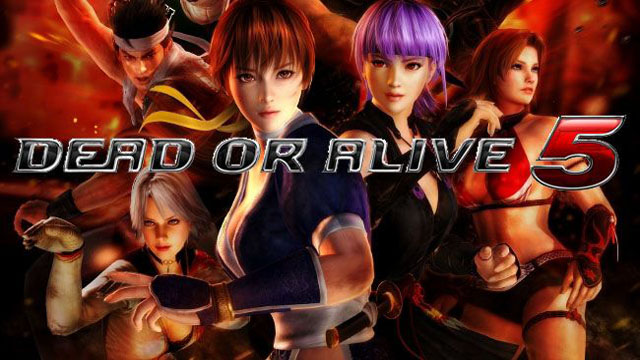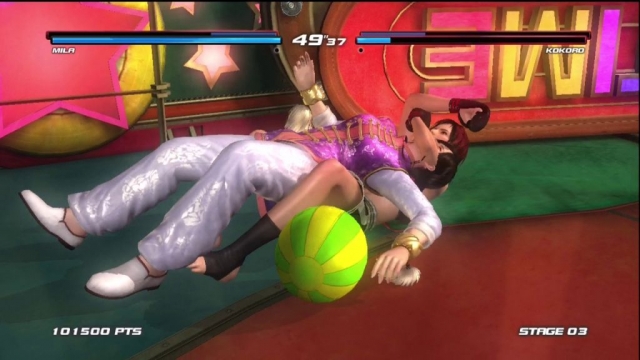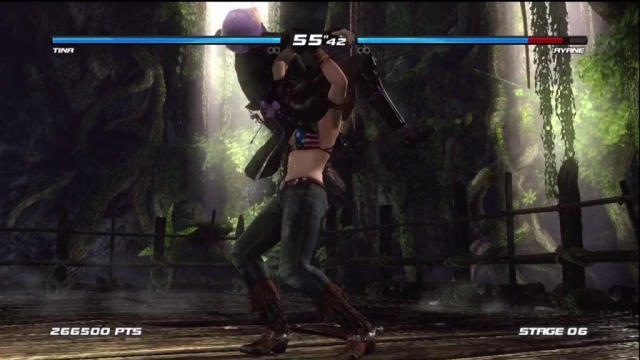Dead or Alive 5 Review

It’s been a great year for 3D fighting fans. 2012 has seen the release of new entries for SoulCalibur, Virtua Fighter, Tekken, and now DOA with Dead or Alive 5. Having played all of these games, plus their predecessors, I can honestly say that DOA 5 feels the most like what you’d expect a current-gen game to be. It doesn’t feel like a higher-res version of something from the prior generation, and delivers the best and most accessible entry in the series yet.
DOA 4 was very good, but also incredibly tough – Tecmo definitely listened to complaints because this (and to be fair, Dimensions before it) don’t just set out to kill you. They’ve taken a more traditional fighting game approach to things as opposed to say, a Ninja Gaiden approach that is all about challenge. There’s plenty of challenge here, but you’re eased into it. You can choose to play offline in a ton of modes. You’ve got the usual arcade mode, a survival mode, time attack, a training mode, and tag team versions of each. Survival mode is my favorite of the bunch since arcade doesn’t have a story and just takes more time. It forces you to fight smart since your health bar doesn’t quite refill between battles, and pits you against ten foes one after the other. You’ve got a handful of difficulty options to choose from, and it’s definitely best to work your way up to avoid feeling overwhelmed. You’ll struggle, then you’ll beat eight enemies, then nine, then you absolutely won’t be able to stop until you beat the tenth foe. It’s exhilarating and provides some of the most fun in the game. There’s also a lot of fun to be had just doing versus matches, saving replays, and taking dazzling-looking snapshots from them. Like a photo mode in a racing game, there’s something special about nabbing that perfect shot.
Like DOA: Dimensions for the 3DS, DOA 5 focuses on telling a very long tale that encompasses as much of the cast as humanly possible and actually develops the characters to some degree – or at least explains who they are and what their motivations are. For many, it seems to be “you are in shape and within ten feet of me, SO WE MUST FIGHT”, which I’m fine with since there are other, far more wacky things like Zack blasting into a circus tent as a human cannonball to invite two fighters to the tourney. The story mode is a fine mix of serious and silly, and is impossible to not enjoy. For goodness sake, what other story mode is going to give you cloning and a guy with a Christmas light afro outfit? The acting in it is perfect too – like the story, it’s great B-movie fare that is somewhat self-aware, but not TOO self-aware. Beyond being entertaining to watch, the story mode allows you to unlock titles for yourself, new characters (like a few from the VF series), and teaches you the finer points of the game by giving you optional missions to complete (like countering X amount of times within a fight) in addition to beating your opponent.
So you’ve got tons to do offline, and online lets you do the normal ranked or unranked battles in either one on one or tag team play, and you can also take part in a lobby-based tournament with up to 16 players. There’s some outstanding integration between offline and online play because you can add people you’ve fought online to a list, and then they can challenge you (if you leave the option on) to a battle while you’re offline. It’s basically the same as being in the arcade and having a second player join in, but I can’t recall it being done like this in a home fighting game. The day one patch has seemingly remedied the lag issues I’ve had for about a week with playing it online, and it’s amazing how big a difference that made. Before, you never knew if you’d have a lag-free experience or not. Now, one can rely on having one most of the time, as opposed to occasionally like before.
The stages themselves have been a selling point since the second game, and what that game began with danger zones and multiple tiers is continued on nicely here. Every stage doesn’t just have a distinct look, but requires you to play slightly differently. The wrestling ring area for example has ropes you can spring off of if you’re light enough, while the rig stage is surrounded by fire and giant things that can explode. The military warzone has MISSILES BEING LAUNCHED AT YOU if you land in the wrong spot, so avoid doing that, while the raft stage might just be the most exciting since it starts off serene, and can then quickly escalate into you and your opponent zooming down a river with a broken part of the raft serving as something you can be thrown past and resulting in one of many possible giant falls in the game.
The DOA games have always been heralded for looking great, and this one is no exception. The newly redesigned character models mostly look human now instead of like action figures. With that change comes a more realistic flow for clothing, and little touches like dirt building on the characters as a fight wears on. It’s a little thing, but really impressive to see in action and of course, the backgrounds themselves are still gorgeous with a ton of stuff going on. They’re all intricately-detailed too, and seeing stuff like each individual pipe fall down in one stage and then leading to more craziness goes on remains impressive every time you see it.
Move animations are outstanding and the fluidity of counters is the best in the business. From the slick animation of things like Hiroshi Tanahashi’s Slingblade for Lisa to the more impactful offense like Bass’s punches or Mila’s slams into walls, everything seems exactly as it should. Transition animations are great, and seeing Mila go from a powerslam to an armbar, or tackle into a mount with some ground and pound never ceases to amaze me. Brad Wong’s offense is probably the most impressive to look at because there’s so much going on with every part of his body and yet the animations are unbelievably smooth. They didn’t even try and cut corners when you do stuff like kick him into a handstand – he falls (or flies) as he should…unless you use something super powerful and then he flies many, many feet in the air.
DOA 5’s audio is great overall. The music is fine, but doesn’t really stick with you much afterwards. I love the sound effect work here though. The sound of flames going off in the background of one stage really adds to the intensity and pretty much every stage benefits from little atmospheric touches like that. They go a long way to truly make each stage stand out from the others and not just feel like you could be fighting in any area and it wouldn’t really matter because the only thing that really separates them is how the areas look, with nothing really affecting the game to a greater degree than that.
Overall, Dead or Alive 5 is not only the best entry in the series yet, but my favorite fighting game this generation. It’s got the smoothest gameplay of anything out there now and delivers the goods online more often than not. It also raises the bar for graphics in fighters and has some great animation too. The story mode’s a blast to play through and provides the right mix of drama and B-movie wackiness to make it fun to get through despite its epic length. If you’ve ever loved the series before, make this a part of your collection ASAP, and if you’ve been turned off by it before, at least give it a rental – I’m positive it’ll win you over.
Reviewed By: Jeremy Peeples
Publisher: Tecmo Koei
Rating: 95%
——————————————————————————–
This review is based on the Xbox 360 version of Dead or Alive 5 provided by Tecmo Koei.
 Game Over Online
Game Over Online




















